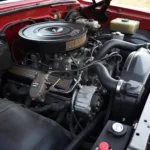You plug your OBD2 scanner into your car’s OBD2 port, expecting it to power on and start diagnosing, but nothing happens. The screen remains blank, and you’re left wondering, “Why is my OBD2 plug not getting power?”. Don’t worry, you’re not alone! This is a common issue faced by many car owners, and we’re here to help you troubleshoot it.
Understanding the OBD2 Port and Power Supply
Before we dive into the reasons behind an OBD2 plug with no power, let’s quickly understand how the system works. The OBD2 port, often located under the driver-side dashboard, is your car’s communication hub for diagnostics. It draws power directly from the car’s battery. When you plug in a scanner, it uses this power to function.
Common Reasons Your OBD2 Plug Has No Power
Now, let’s explore the most common culprits behind your OBD2 power woes:
1. Blown Fuse
The most common reason for an OBD2 port not receiving power is a blown fuse. Your car’s fuse box houses fuses dedicated to various electrical components, including the OBD2 port.
How to Check:
- Locate your car’s fuse box. Consult your owner’s manual for its location.
- Identify the OBD2 port fuse. The fuse box cover usually has a diagram indicating the fuse allocation.
- Inspect the fuse visually. A blown fuse will have a broken wire inside.
- Test the fuse with a multimeter (optional). This provides a more accurate diagnosis.
Solution:
Replace the blown fuse with a new one of the same amperage.
2. Faulty OBD2 Port
While less common, the OBD2 port itself can be damaged or faulty, preventing power flow.
How to Check:
- Visually inspect the port for any bent or broken pins.
- Use a multimeter to check for continuity between the power pin of the port and the battery ground.
Solution:
If the port is damaged, it will need to be replaced by a qualified mechanic.
3. Car Battery Issues
A dead or weak car battery often means insufficient power to run various electrical components, including the OBD2 port.
How to Check:
- Try jump-starting your car. If the OBD2 port works after jump-starting, it indicates a battery issue.
- Test your battery with a multimeter. This will show the battery’s voltage and overall health.
Solution:
Charge your battery or replace it if it’s nearing the end of its lifespan.
4. Wiring Problems
Damaged or corroded wiring between the OBD2 port and the fuse box or battery can disrupt the power supply.
How to Check:
- Visually inspect the wiring harness leading to the OBD2 port for any signs of damage, wear, or corrosion.
- Use a multimeter to test for continuity along the wiring.
Solution:
Repair or replace any damaged or corroded wiring.
5. Aftermarket Electrical Issues
Modifications to your car’s electrical system, like installing aftermarket alarms or audio systems, can sometimes interfere with the OBD2 port’s power supply.
How to Check:
- Consider if any recent electrical modifications coincide with the OBD2 power issue.
- Temporarily disconnect any recently added electrical components to see if it resolves the issue.
Solution:
Consult a qualified auto electrician to diagnose and rectify any conflicts caused by aftermarket installations.
Additional Tips for Troubleshooting
- Check your OBD2 scanner: Before you start tearing apart your car’s electrical system, ensure that your OBD2 scanner is functioning correctly. Test it on another vehicle or try using a different scanner.
- Consult your owner’s manual: Your car’s owner’s manual is a treasure trove of information. It often includes details about the fuse box diagram, OBD2 port location, and other relevant electrical components.
- Seek professional help: If you’re uncomfortable working with electrical components or haven’t been able to resolve the issue yourself, don’t hesitate to seek help from a qualified mechanic.
Conclusion
An OBD2 plug with no power can be frustrating, but with a little troubleshooting, you can often pinpoint the culprit and get your diagnostic scanner up and running. Remember to prioritize safety when working with electrical components. If in doubt, always consult a professional.
FAQ
1. Can I drive my car with a blown OBD2 port fuse?
Yes, you can usually drive your car with a blown OBD2 port fuse. However, this will temporarily disable your OBD2 port, preventing you from using a scanner for diagnostics.
2. How much does it cost to fix an OBD2 port with no power?
The cost of repair depends on the underlying cause. A simple fuse replacement might cost a few dollars, while replacing a damaged OBD2 port or repairing wiring issues could range from $50 to $200 or more.
3. Can I use an OBD2 obd2 wireless bluetooth adapter if my OBD2 port has no power?
No, wireless OBD2 adapters still require power from the OBD2 port to function.
4. What is an amp research power step obd2 plug?
This refers to a specific type of plug used in certain aftermarket running boards, like those from AMP Research. It’s not directly related to the issue of an OBD2 plug with no power.
Need further assistance?
We understand that diagnosing car issues can be complex. If you require personalized guidance or expert advice, our dedicated team of automotive specialists is here to assist you 24/7. Reach out to us via WhatsApp at +1(641)206-8880 or email us at [email protected]. Let us help you get back on the road with confidence!

